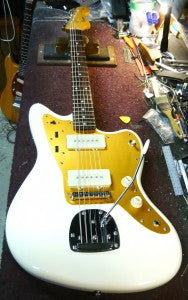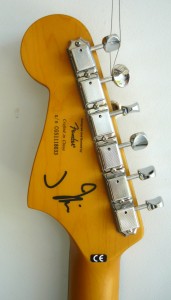So, let me start this review for those of you who don't read my stuff a lot by saying, at the risk of sounding like a grumpy old man, it takes a lot to impress me these days when it comes to new guitars, and I don't normally deal in Chinese made guitars at all. It's not that I think they're all crap, it's the social and global implications of them that I'm opposed to. Having said that it's nearly impossible to NOT deal with them in the today's mass-produced world.
So this came in the mail for me the other day sent from the US by J Mascis (actually Dave his tech posted it) for me to have. I've owned, played and worked on a few Jazzmasters over the years from '59 to new inc some of J's personal ones and I play Jazzmasters in my band, so I know "a little" bit about them. I actually love the JM design and concept and think it was probably Leo's finest work in guitar form.
When I heard J was endorsing a Squier version of his favorite guitar I thought it was great. I've owned a bunch of the Japanese issued signature sparkle purple ones and had one that was a very good guitar indeed but owning a guitar shop means sometimes you move on stuff that you would otherwise keep, and they all went in favor of other Jazzmasters I own.
I love the idea of J (or any recognized player) endorsing a cheaper version of their gear, especially if it's a little "unusual" so kids can get into playing stuff they wouldn't normally have access to and this fits that bill perfectly.
Squier (or Fender) have been "re-issuing" the "offset" for some time but it's never actually a re-issue. There's Jagmasters, and HH Jags, and blacktops and ........... well, lots of offset type guitars in the cheaper Squier versions but they're never really an accurate re-issue. Well, neither is this for those of you wanting a vintage spec Jazzmaster. It is however as close as you're currently going to get and it's a pretty cool guitar, especially for the price.



This is the first time Fender has issued a "Jazzmaster" that actually pretty much looks, plays and sounds "LIKE" a Jazzmaster for anywhere near this price. This guitar has things I love and things I like, but pretty much nothing that I don't like, which is pretty cool.
For starters, it looks pretty much like a JM, and a very cool one at that. I love the blonde and gold guard look. Probably even more than the sparkle purple. The finish is great and flawless as most of the cheaper Asian guitars are now days. It's a pretty thick coat which makes it look a little like a fridge but still very nice. A more "see through" blonde might have been nicer, but hey, we're going to keep coming back to "the price" with these things.
The body is solid basswood, which I personally don't have a problem with at all. Some people say basswood is too "average" for guitar bodies without clarity in any particular frequencies. I personally haven't found this and I don't think the type of timber a body is made of has as much effect on tone as most people would think or have you believe. The neck is maple, albeit an Asian type of maple that isn't as hard as the US type commonly used on Fender products. The neck finish is listed as "satin" which in this form feels a lot like gloss. I know J wanted a bare (unfinished) neck on both this and the Japanese version, but Fender wouldn't comply.
The neck is probably a little too thick for my liking and is a C shape that tends to give just a hint of a V but is very comfortable and quite easy to play. The rosewood fretboard is a nice piece of timber and the fretwork and neck is well finished and straight. I didn't even do a fret dress on this, which I would normally do on any new Chinese instrument. I'm also not a fan of jumbo frets but these are well dressed and there's no buzzing anywhere. I know J likes thicker necks and jumbo frets, so these two options are obviously for his style.
The bridge is a Gibson style tune-o-matic like J runs on his JM's and is a common conversion these days for offsets. Now, here's where the first interesting "mod" comes in. The vibrato is located 15mm closer to the bridge than a standard JM. This was part of the "problem" with standard JM's and it's part of the reason they have bridge problems. By moving the vibrato closer they are increasing the string angle over the bridge and putting more pressure on the bridge. This does two things. It stops the strings from popping out of the saddles when strummed hard AND it increases sustain and "tone" at this point. It's a great thing and well done to J and Fender doing it.
The vibrato is the usual JM style but without the lock down mechanism. The arm is slightly shorter than the standard reissue arm which is probably to compensate for the vibrato being moved. A "normal" arm would make the tip further down towards the neck. It works well and is adjustable for tension like the original.
The pickups are the other BIG departure from the original JM design, and I can't wait to talk to J about these. The original JM pickup was a big fat single coil. It's size and shape gave it a very deep but clear tone that suggested it was really meant to be used for ........... well, jazz. Later JM's had slightly different bobbin shapes and tended to sound more trebly and the Japanese re-issues have always had what is essentially a Strat style bobbin wound on JM flatwork giving them a much thinner and Strat like tone.
These are essentially P-90's ..................... Yeah. These are fitted into standard looking JM covers but are basically very similar in construction to P-90's It has a row of adjustable pole pieces that runs through the bobbin with two bar magnets running along the bottom on either side. Sound familiar? Well, it essentially how a P-90 is made. Now I LOVE P-90's. I think they're THE BEST pick up ever, but they're NOT Jazzmaster pickups. These have a bit more "meat" than a JM pick up and sound .........really good. If you're after a true JM sound, you'll need to swap them out but for the price of the guitar you can afford to spend a little extra on pickups if you don't like these. I think they sound great. They still have the single coil bark but with a smoother mid and bottom end than a JM pickup and with HEAPS of gain on them they still hold it together surprisingly well. Better dare I say it than US re-issue ones.
The electronics are average but up to the job and better than most Chinese guitars I've worked on. There's shielding right through the cavities and the back of the plate, and the output jack has a dedicated earth. The switches are all tight and there's no crackles anywhere.
Straight out of the box it played surprisingly well. I put 11-52's on it and left it to settle in. After a quick going over for action and intonation it was great. I still haven't done a fret dress or adjusted the nut height or truss rod.
So, as I said before this is as close as you're going to get if you want a cheap Jazzmaster. If you don't like signature models the only give away is the printed signature on the back of the headstock (and on the front on mine) which you (and the audience) can't see while you're playing it. If you're into offsets this guitar is amazing for the price. It has the looks and feel of a really good Jazzmaster with some mods that you may or may not like but don't detract from the guitar at all, and except for the closer vibrato (a VERY good thing) the rest can be changed to vintage spec if wanted.
With the price being so low on this one I would say take it to someone who knows how to set up Jazzmasters and get a good set up, and if you want actual JM pickups, a set of them as well and you'll have yourself a great sounding and playing offset still for a great price.
If I was after a Jazzmaster and couldn't justify a vintage one and didn't want to spend too much on a re-issue, I'd be getting one (or two) of these no problem. I'm not sure if these are being made in huge numbers and/or are an ongoing product, but Fender is going to sell these in droves. Anyone looking for an offset that looks great, plays great and sounds great couldn't go past one for the price. You know what's better than a good expensive guitar? A good cheap one.
A blog about the new EH JM Big Muff








